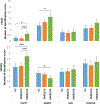Deficits in emotion recognition are associated with depressive symptoms in youth with disruptive mood dysregulation disorder
- PMID: 30004611
- PMCID: PMC9719110
- DOI: 10.1002/da.22810
Deficits in emotion recognition are associated with depressive symptoms in youth with disruptive mood dysregulation disorder
Abstract
Background: Although severe irritability is a predictor of future depression according to recent meta-analytic evidence, other mechanisms for this developmental transition remain unclear. In this study, we test whether deficits in emotion recognition may partially explain this specific association in youth with severe irritability, defined as disruptive mood dysregulation disorder (DMDD).
Methods: Participants aged 8-20 years (M = 13.3, SD = 2.8) included youth with DMDD, split by low depressive (DMDD/LD; n = 52) and high depressive (DMDD/HD; n = 25) symptoms, and healthy controls (HC; n = 39). A standardized computer task assessed emotion recognition of faces and voices of adults and children expressing happiness, fear, sadness, and anger. A Group (3) × Emotion (4) × Actor (2) × Modality (2) repeated measures analysis of covariance examined the number of errors and misidentification of emotions. Linear regression was then used to assess whether deficits in emotion recognition were predictive of depressive symptoms at a 1 year follow-up.
Results: DMDD/HD youth were more likely to interpret happy stimuli as angry and fearful compared to DMDD/LD (happy as angry: p = 0.018; happy as fearful: p = 0.008) and HC (happy as angry: p = 0.014; happy as fearful: p = 0.024). In youth with DMDD, the misidentification of happy stimuli as fearful was associated with higher depressive symptoms at follow-up (β = 0.43, p = 0.017), independent of baseline depressive and irritability symptoms.
Conclusions: Deficits in emotion recognition are associated, cross-sectionally and longitudinally, with depressive symptoms in youth with severe irritability. Future studies should examine the neural correlates that contribute to these associations.
Trial registration: ClinicalTrials.gov NCT00025935.
Keywords: depression; emotion; facial recognition; irritable mood; voice recognition.
© 2018 Wiley Periodicals, Inc.
Conflict of interest statement
CONFLICTS OF INTEREST
Dr. Stringaris, before assuming his duties at NIMH in 2016, had received funding from the Wellcome Trust and the UK National Institute of Health Research, funds from University College London for a joint project with Johnson & Johnson and royalties from Cambridge University Press and Oxford University Press. The rest of the authors report no financial relationships with commercial interests.
Figures



References
-
- Althoff RR, Crehan ET, He JP, Burstein M, Hudziak JJ, & Merikangas KR (2016). Disruptive mood dysregulation disorder at ages 13–18: Results from the national comorbidity survey-adolescent supplement. Journal of Child and Adolescent Psychopharmacology, 26(2), 107–113. 10.1089/cap.2015.0038 - DOI - PMC - PubMed
-
- Axelson DA, & Birmaher B (2001). Relation between anxiety and depressive disorders in childhood and adolescence. Depression and Anxiety, 14(2), 67–78. - PubMed
Publication types
MeSH terms
Associated data
Grants and funding
LinkOut - more resources
Full Text Sources
Other Literature Sources
Medical
Research Materials

